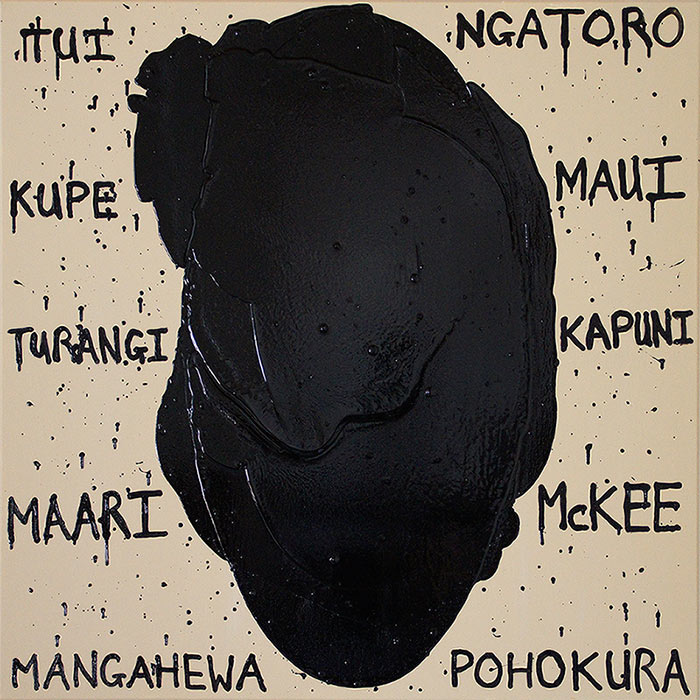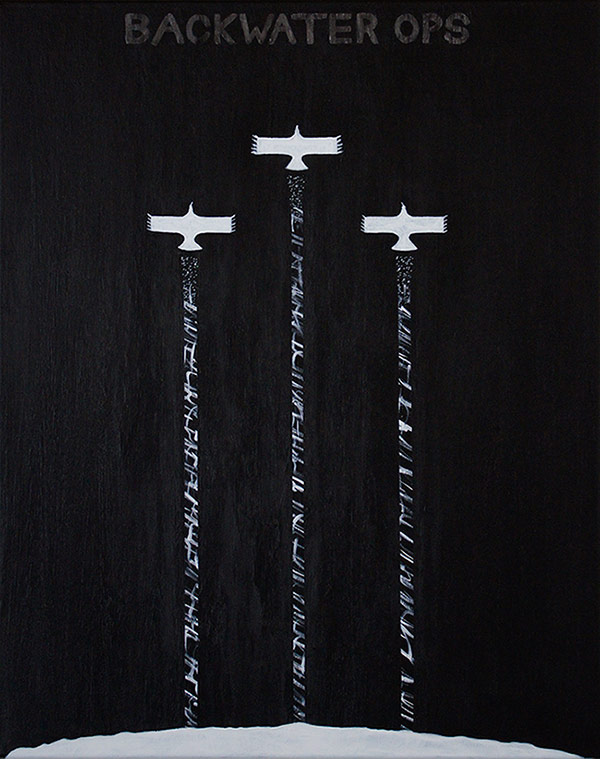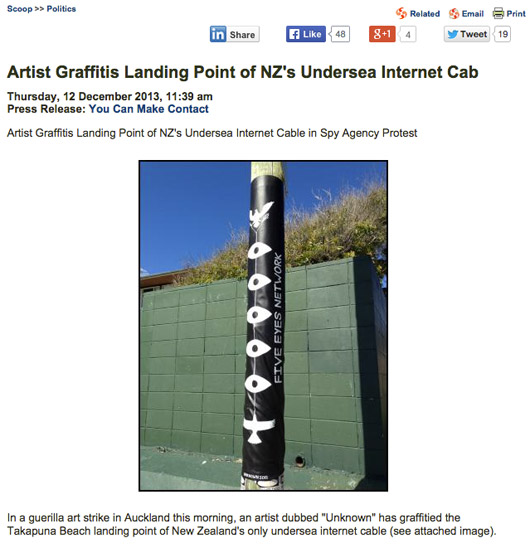All posts in painting
2016 National Contemporary Art Award Exhibition
My painting The Oil Fields (image below) has been included in the 2016 National Contemporary Art Award. The exhibition of the 34 finalists’ work has been on show at Waikato Museum Te Whare Taonga o Waikato since early September and ends soon, on 4 December.
The judge and curator for the award this year was Misal Adnan Yildiz, the current director of Artspace NZ. In his Judge’s statement Adnan noted that, “Today, from Orlando to Istanbul gender politics are still relevant. The questions around immigration, integration and refugees are urgent. ‘The end of neoliberalism’ is not just a title for an article printed by Monocle magazine; it is a reality that surrounds us. We are seeing the end of things and the new beginnings every day, every moment, every second, more and more… “, and ” I am proud that the exhibition of finalists for the 2016 National Contemporary Art Award is based on questions we can share with the rest of the world.”
I assume this sociopolitical inclination was a big part of the reason my work was selected from the hundreds of entries. My mandatory statement accompanying my entry (and printed on the label beside the work in the gallery) reads, “The Oil Fields lists names of active oil fields in Aotearoa, alongside a painterly depiction of a crude oil spill. The painting is part of an ongoing series recognising that in the early twenty-first century we are still fully immersed in the Oil Age.
Despite the emergence of the digital era, the exponential growth of renewable energy around the world, and escalating climate change, world oil consumption has continued to increase over recent decades.
We are drilling for oil deeper in the oceans than ever before, and extracting unconventional forms of oil such as shale oil and tar sands oil. It is inevitable that the Oil Age will come to an end as the world transitions to more sustainable forms of energy, but how long will it take?”
Overall, having work in the 2016 National Contemporary Award has been a really positive experience. I can’t say reading the largely negative EyeContact review by Peter Dornauf gave me much pleasure though. I’m not sure why EyeContact would choose a conservative critic to review such a show, but as I said in my social media, I’m claiming Dornauf’s trumped-up, derogatory labelling of my work: Neo-Casual Propaganda. It’s quite catchy.
Notes on Backwater Ops Paintings
Below are some notes on ideas and influences associated with my recent Backwater Ops series. While not exhaustive, they represent some of my intentions and thoughts when making the work.
Backwater
Most viewers are unlikely to get this reference, but for me the series title Backwater Ops is partly a play on Blackwater, which was the name of a private military firm (later changed to Academi). Blackwater is also the title of a bestselling book about that secretive company, or rather mercenary army, by investigative journalist Jeremy Scahill. The book details how Blackwater became one of the most powerful players in the Iraq War, and in the ongoing War on Terror in many countries.
Scahill went on to co-found The Intercept with well known investigative journalist Glenn Greenwald and documentary filmmaker Laura Poitras. They were the people Edward Snowden entrusted to reveal his leaked NSA documents to a shocked world. These leaks revealed how the NSA, along with its international Five Eyes spy agency partners, including New Zealand’s GCSB, had in secret been building the largest and most pervasive infrastructure for mass surveillance the world has ever known.
More obviously than the Blackwater reference, I also chose the title Backwater Ops to allude to New Zealand’s involvement in this international spy alliance. No doubt New Zealand plays a small but important role in the five-country Five Eyes network, but it can be considered a backwater compared to the military intelligence might of the US and UK.
In social media I have jokingly referred to New Zealand as being at the very end of the internet, an internet backwater, but of course everyone online is now connected by mere moments, whatever their geographical location. Although internet communication is close to instant now, in an increasingly globalised world, including the art world, New Zealand can still be considered a backwater. It’s far away from the major “art centres” such as New York, London, and Berlin. However, although remote, a backwater can be used to create and hold important secrets, and to develop secret projects, out of view from prying eyes.
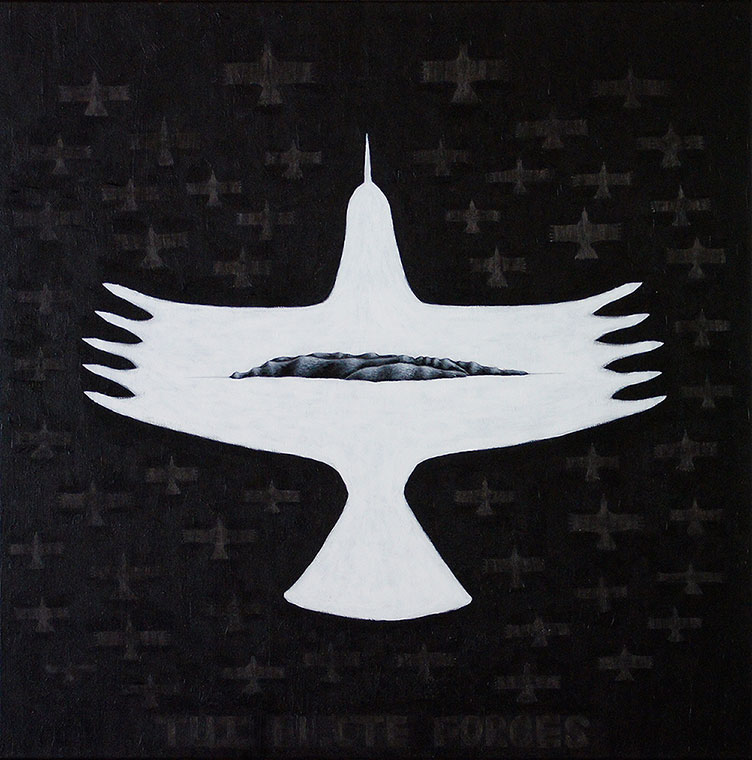
Post-Snowden
Like many people around the world, I was shocked to learn of Edward Snowden’s revelations about the Five Eyes alliance and its extensive, ever-growing surveillance capabilities. I was transfixed by the regular articles from The Intercept, mainly by Glenn Greenwald, and the world’s reactions to Snowden’s leaks. The internet has become a huge part of our daily lives, and the new knowledge that government spy agencies were using it to conduct mass surveillance worldwide made people realise that the supposedly democratic internet had changed dramatically; it had become militarised.
Immediately before my Backwater Ops series, in late 2013 and early 2014, when the public debate surrounding spy agencies and mass surveillance was in full swing internationally, I created a couple of works on the Five Eyes theme. These works included an outdoor guerrilla artwork at the landing point of New Zealand’s only undersea internet cable (see Five Eyes Network – Outpost and Five Eyes Network – Outpost). Snowden’s leaks had revealed the Five Eyes intention to tap the massive amount of data running through this Southern Cross cable. It was not clear how far that work had progressed, or if it had already being carried out. After the Snowden leaks, many assumed it was already happening.
Secret Military Patches
I want to mention the influence of the work of American artist, geographer, and author Trevor Paglan on my Backwater Ops series. Before making this work, I had read his book I Could Tell You But Then You Would Have to be Destroyed by Me. The book takes a look at the US military’s secret projects, which of course the rest of the world is not supposed to know anything about. Although top secret, it seems the military still creates identifying patches (worn on military uniforms) for these top secret ops.
Like my Backwater Ops paintings, these real military patches offer some cryptic clues about the nature of the classified projects they represent. The imagery is often aggressive, sinister, full of military bravado, yet often cartoonish. Paglan’s book documents a collection of more than 70 patches representing secret military projects, including secret weapons projects, intelligence operations, and secret aircraft squadrons. Often the patches use animal graphics, and of course nationalistic emblems.
These weird but real patches were partly a springboard for my approach to the Backwater Ops paintings. I began asking myself questions: as a Five Eyes partner, what if little Aotearoa New Zealand in the South Pacific also undertook top secret military projects, and produced imagery to do with these? What might that imagery look like? Further, what might the imagery look like if society took a distinctly dystopian path, where total surveillance and authoritarian rule became an everyday reality?
Backwater Ops is the result. It deals with an imagined, dystopian national identity. Like the real military patches Paglan collects, I’ve made use of some iconic national wildlife – tui, huia, tuatara, kiwi, kokako, ruru – as well as some other familiar national emblems and landscape imagery.

Wildlife and Environment
In the work, some of New Zealand’s iconic birds, the ancient tuatara, and an indigenous bat, have been transformed into authoritarian emblems representing a malevolent future. The Tui Elite Forces patrol a local landscape (Auckland’s Waitakere Ranges) like surveillance drones. The secret mission assigned to the native bat is to Collect All Signals All The Time. According to the classified NSA documents leaked by Edward Snowden, this is a stated goal of the NSA. In another work, a sinister, waspish emblem ominously states: Let Them Hate, So Long As They Fear. This well known quote is attributed to Roman Emperor Caligula and still surfaces from time to time in relation to tyrannical regimes and individuals.
The kōkako is heroically surviving Against All Odds. In this dystopian future, the struggling kōkako has been appropriated as an emblem of state and military survival. However, in Huia Forest Forces the (extinct) huia has had its military Operations Terminated.
The nocturnal and secretive ruru (or morepork) proclaims We Own The Night, and the prehistoric tuatara warns you to Keep Your Distance – as the public is cautioned to do in real life for reasons of conservation of the species. The secretive, and most iconic of all, kiwi bluntly announces in internet and texting shorthand that its Backwater Ops mission is simply NOYFB: None of Your Fucking Business.
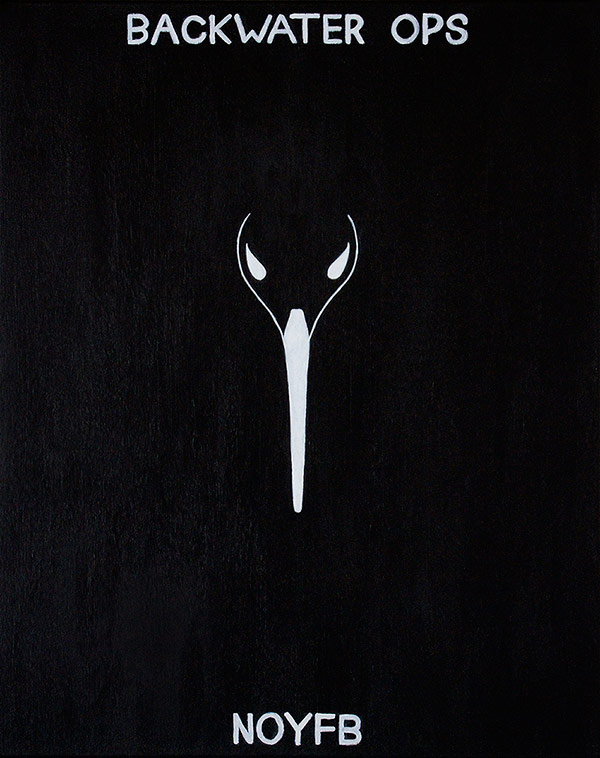
The Social Life of a Guerilla Artwork: Five Eyes Network Outpost
In this post, I’m going to document some of the extended life my guerilla-style Five Eyes Network artwork has had in social media since being created.
Guerilla Art Strike: December 2013
The Five Eyes Network Outpost artwork was created in late 2013, in the midst of the vigorous worldwide debate surrounding mass surveillance conducted by spy agencies, revealed by NSA whistleblower Edward Snowden. In New Zealand, the controversial GCSB Amendment Bill to expand GCSB intelligence agency powers had generated heated public debate. New Zealand is one of the five countries in the Five Eyes intelligence agency alliance.
Snowden had revealed that the NSA routinely tapped enormous amounts of data from fibre optic cables carrying internet traffic around the world. It had also been revealed by Wikileaks in 2010 that, according to a classified document, the Southern Cross undersea cable landing point in Auckland had been labelled “critical infrastructure and a key resource” by the United States government.
In early December, I anonymously installed the guerilla-style artwork around the large telephone pole on Takapuna Beach that marks the landing point of the Southern Cross Cable, which carries most of New Zealand’s internet data to and from the United States and Australia.
A media release was issued, including a photograph of the installed work. A Scoop web page (above image) carrying the release, and social media images of the work, were shared a reasonable amount in social media in the following few days. The physical work was seen by hundreds on popular Takapuna beach during this early-summer week.
Legend: A guerrilla artist has graffitied the landing point of NZ’s Southern Cross Internet Cable in Spying Protest http://t.co/vb0rQYRgPc
— Seeby (@seeby) December 11, 2013
Above tweet: Seeby Woodhouse is the founder of @Orcon, founder and CEO of @VoyagerInternet, and a was high profile digital privacy activist during the public debate surrounding the GCSB Amendment Bill.
After a week, to my surprise the physical work (an acrylic painting on unstretched canvas) was still there. I took it down. I was not expecting to be able to keep it, but was glad to be able to.
The Day We Fight Back: February 2014
On February 11, 2014, to coincide with the international online protest ‘The Day We Fight Back’ against mass surveillance, I shared images in social media of a new but similar follow-up painting on stretched canvas, Five Eyes Network, as well as images of the previous outdoor work. I posted images on Twitter, Instagram, Facebook, Pinterest, Flickr, and wrote an accompanying blog post: Five Eyes Network Painting And The Day We Fight Back.
On the day, thousands of websites around the world, including Reddit, Mozilla and Wikipedia took part in the online protest.
This time the online sharing of the work took off to a greater degree, and continued for days as the public debate continued in New Zealand. As a high profile example, Kim Dotcom (with over 360,000 Twitter followers) tweeted a link to the work to emphasise his assertion that the Southern Cross Internet Cable was indeed being tapped for mass surveillance purposes by the Five Eyes alliance.
One cable connects New Zealand with the rest of the world. One single cable with Five Eyes reading all your emails. http://t.co/g9Sf7nuRxb
— Kim Dotcom (@KimDotcom) February 17, 2014
The result was that many thousands more people saw the work in social media, and were sent to the artwork’s page on my art site. By this stage, many more people had seen the work than if it had been in a public gallery in New Zealand, and it had been dropped into the public debate twice.
NZ Election Campaign and the Southern Cross Cable: September 2014
In September 2014, leading up to the general election in New Zealand, Pulitzer Prize-winning investigative journalist Glenn Greenwald visited New Zealand to present what Edward Snowden’s documents had revealed about the existence of mass surveillance on New Zealanders.
Greenwald wrote a series of articles detailing how the New Zealand government had not been truthful with the public about mass surveillance, and that a plan to tap the Southern Cross Internet Cable had begun to be implemented.
This is where the Southern Cross Internet Cable arrives in NZ. Here it’s marked with a Five Eyes sign. #nzpol #art pic.twitter.com/lWFdyZMDgB
— John Johnston (@jjprojects) September 15, 2014
Just a few days before the election, Kim Dotcom, together with his new Internet MANA political party alliance, hosted a high profile media event called The Moment of Truth, showcasing the new revelations. At the event Greenwald showcased the documents, and Snowden appeared via video link from asylum in Russia, along with Julian Assange from asylum in the Ecuadorian embassy in London. Snowden maintained that he knew for a fact that mass surveillance was being conducted on New Zealanders, as he himself had worked with relevant data records while working with the NSA.
Snowden’s previously top secret documents demonstrated that the GCSB, with NSA cooperation, had implemented Phase I of the mass surveillance program code-named “Speargun” at some point in 2012 or early 2013 – just months before my Five Eyes Network Outpost work was installed. “Speargun” involved the covert installation of “cable access” equipment, which appeared to refer to “surveillance of the country’s main undersea cable link, the Southern Cross cable,” Greenwald wrote. He added, “This cable carries the vast majority of internet traffic between New Zealand and the rest of the world, and mass collection from it would mark the greatest expansion of GCSB spying activities in decades.”
On the day Greenwald’s was story was published, I again tweeted an image (above tweet) of my previous Five Eyes Network Outpost work, with #nzpol (New Zealand politics) and #art hashtags, inserting the tweet directly into the considerable political conversation happening on Twitter at the time. The image was retweeted and commented on many times during that day, and spread through social media to thousands more people, in the context of an important public debate.
It remains to be seen whether or not this work has any online social life left in it, but I’m amazed at how far it has travelled so far, from its initial guerilla-installation on a public beach in Auckland just over 9 months ago.
Although it’s had a decent public life already, I would eventually like to show the follow-up painting, Five Eyes Network, in a physical art gallery! A new series of paintings I’m working on now also relates to this work.
New ‘Five Eyes Network’ Painting And ‘The Day We Fight Back’
Below is an image of my latest painting, Five Eyes Network. This new painting is similar to a recent guerilla art piece, Five Eyes Network, Surveillance Outpost, previously installed at the Takapuna Beach, Auckland landing point of New Zealand’s only undersea internet cable.
I’m sharing this new Five Eyes Network painting now to coincide with The Day We Fight Back against mass surveillance. Thousands of websites, including Reddit, Mozilla and Wikipedia are planning a massive protest on Tuesday, February 11th. I’m joining them with this website, my other site The9Billion, and with my various social media profiles.
Images of this painting are licensed under Creative Commons Attribution-NonCommercial 3.0 Unported License, so feel free to take a copy for yourself, and to share it with others. Larger, higher resolution images can be downloaded from my Flickr profile.

